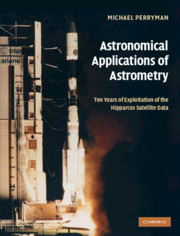Book contents
- Frontmatter
- Contents
- Preface
- 1 The Hipparcos and Tycho Catalogues
- 2 Derived catalogues and applications
- 3 Double and multiple stars
- 4 Photometry and variability
- 5 Luminosity calibration and distance scale
- 6 Open clusters, groups and associations
- 7 Stellar structure and evolution
- 8 Specific stellar types and the ISM
- 9 Structure of the Galaxy
- 10 Solar System and exoplanets
- Appendix A Numerical quantities
- Appendix B Acronyms
- Appendix C Author gallery
- Index of first authors
- Subject index
2 - Derived catalogues and applications
Published online by Cambridge University Press: 23 November 2009
- Frontmatter
- Contents
- Preface
- 1 The Hipparcos and Tycho Catalogues
- 2 Derived catalogues and applications
- 3 Double and multiple stars
- 4 Photometry and variability
- 5 Luminosity calibration and distance scale
- 6 Open clusters, groups and associations
- 7 Stellar structure and evolution
- 8 Specific stellar types and the ISM
- 9 Structure of the Galaxy
- 10 Solar System and exoplanets
- Appendix A Numerical quantities
- Appendix B Acronyms
- Appendix C Author gallery
- Index of first authors
- Subject index
Summary
Introduction
The use of photography to determine star positions began around 1870, flourished with the immense international cooperation of the Carte du Ciel project to map the entire celestial sphere to about 15 mag, and remained one of the most important astrometric techniques until the last decade or so of the twentieth century. Schmidt telescopes were constructed, from the 1930s onwards, with astrometry as their main objective. Such surveys have only recently been superseded by ground-based digital surveys in terms of classifying large numbers of very faint objects. In parallel, fast and accurate measuring machines and associated reduction software were developed. Kovalevsky (2002) provides details of the underlying techniques, including image formation, atmospheric effects, and plate measurements and reductions.
The development of stellar reference frames during the second half of the twentieth century has comprised both meridian and photographic observational campaigns, the former to provide reference stars with a density of about one star per square degree for the reduction of the plates obtained in the latter.
Hipparcos has allowed a re-calibration of basic meridian circle observations, of photographic plates, and of other classical astrometric instruments (Figure 2.1). Telescopes used may be classical astrographs (typified by the Carte du Ciel refracting astrograph of field ˜2°), Schmidt telescopes (with a larger field of view of ˜6°, using reflectors to minimise chromatic aberration and a correcting optical element to control spherical aberration), and long-focus instruments to obtain a larger image scale: either using refractors equipped with photographic plates, such as the Sproul in Princeton, or using reflectors as in the US Naval Observatory 1.55-m Strand telescope at Flagstaff (Figure 2.15 below).
- Type
- Chapter
- Information
- Astronomical Applications of AstrometryTen Years of Exploitation of the Hipparcos Satellite Data, pp. 54 - 90Publisher: Cambridge University PressPrint publication year: 2008



